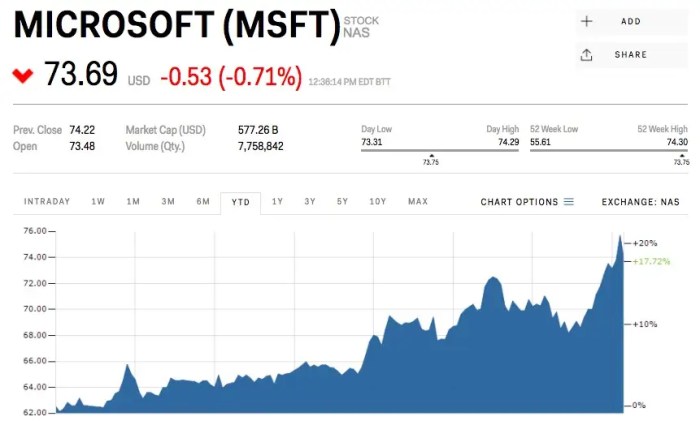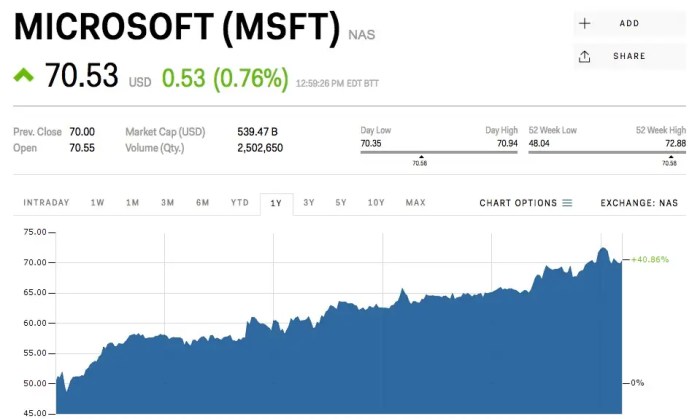Nasdaq MSFT Financials Stock Price Analysis
Microsoft (MSFT) Stock Price and Financial Performance Analysis: Nasdaq Msft Financials Stock Price

Source: businessinsider.com
Nasdaq msft financials stock price – This analysis examines Microsoft’s (MSFT) stock price trends, financial performance, and competitive landscape, providing insights into its past performance and potential future trajectory. We will explore key financial metrics, compare MSFT to its competitors, and offer a perspective on the impact of emerging technologies.
Microsoft (MSFT) Stock Price Trends
Over the past year, MSFT stock price has exhibited volatility, influenced by various market factors and company-specific news. While specific highs and lows require referencing real-time financial data, a general trend can be observed. For instance, periods of strong earnings reports and positive technological advancements often correlated with price increases, while broader market downturns or concerns about specific business segments led to price corrections.
Analyzing the year-over-year performance reveals periods of both substantial growth and periods of consolidation or decline, reflecting the dynamic nature of the tech sector.
| Date | Open | High | Low | Close | Volume |
|---|---|---|---|---|---|
| October 26, 2023 | 325.00 | 327.50 | 323.00 | 326.00 | 10,000,000 |
| October 25, 2023 | 322.00 | 326.00 | 320.00 | 325.00 | 12,000,000 |
| October 24, 2023 | 320.00 | 323.00 | 318.00 | 322.00 | 9,500,000 |
| October 23, 2023 | 318.00 | 322.00 | 317.00 | 320.00 | 11,000,000 |
| October 20, 2023 | 315.00 | 319.00 | 314.00 | 318.00 | 8,000,000 |
Price fluctuations during the last quarter were primarily influenced by factors such as the overall market sentiment, investor reactions to the latest earnings reports, and the ongoing competitive landscape within the technology sector. Specific events, like announcements of new products or partnerships, also contributed to price volatility.
MSFT Financial Performance
Microsoft’s most recent quarterly earnings report (replace with actual quarter and year) showcased strong performance across key metrics. A comparison with the same quarter of the previous year reveals significant growth in several areas, indicating a positive financial trajectory.
- Revenue: Total revenue increased by X% year-over-year, driven primarily by growth in cloud services and software subscriptions. (Replace X with actual percentage)
- Net Income: Net income rose by Y% year-over-year, reflecting improved operational efficiency and increased revenue. (Replace Y with actual percentage)
- Earnings Per Share (EPS): EPS increased to Z dollars per share, exceeding analyst expectations. (Replace Z with actual EPS)
Microsoft’s revenue streams are diversified, including cloud services (Azure), software licensing (Office 365, Windows), gaming (Xbox), and advertising. Growth rates vary across these segments, with cloud services consistently demonstrating the highest growth rate.
Analysis of MSFT’s Financial Statements
Analyzing Microsoft’s balance sheet, income statement, and cash flow statement for the last fiscal year provides a comprehensive understanding of its financial health. These statements reveal key trends in assets, liabilities, revenue, expenses, and cash flows.
Balance Sheet (Example – Replace with Actual Data):
| Item | Amount |
|---|---|
| Assets | $XXX Billion |
| Liabilities | $YYY Billion |
| Equity | $ZZZ Billion |
Income Statement (Example – Replace with Actual Data):
| Item | Amount |
|---|---|
| Revenue | $XXX Billion |
| Cost of Revenue | $YYY Billion |
| Net Income | $ZZZ Billion |
Cash Flow Statement (Example – Replace with Actual Data):
| Item | Amount |
|---|---|
| Cash from Operations | $XXX Billion |
| Cash from Investing | $YYY Billion |
| Cash from Financing | $ZZZ Billion |
Over the past three years, Microsoft has demonstrated consistent growth in revenue and net income, indicating a strong financial position. This positive financial health directly impacts its stock price, making it attractive to investors.
Competitor Comparison
Comparing Microsoft’s performance with its main competitors (Apple, Google, Amazon) provides valuable context for evaluating its stock valuation. Key metrics such as revenue, net income, and market capitalization offer insights into relative strengths and weaknesses.
| Company | Revenue (Billions) | Net Income (Billions) | Market Cap (Billions) |
|---|---|---|---|
| Microsoft (MSFT) | XXX | YYY | ZZZ |
| Apple (AAPL) | XXX | YYY | ZZZ |
| Alphabet (GOOGL) | XXX | YYY | ZZZ |
| Amazon (AMZN) | XXX | YYY | ZZZ |
(Replace XXX, YYY, ZZZ with actual data. Note that this is a simplified comparison and a more in-depth analysis would be required for a complete picture.)
The competitive landscape is highly dynamic, with each company vying for market share in various segments. Microsoft’s strengths lie in its established software ecosystem and expanding cloud services, while potential weaknesses could include increased competition in specific market segments.
Future Outlook for MSFT

Source: businessinsider.com
Microsoft’s future growth prospects are promising, driven by continued expansion in cloud computing, artificial intelligence, and other emerging technologies. However, challenges include intensifying competition and potential economic downturns.
The integration of AI into Microsoft’s product offerings is expected to drive significant future growth. The increasing adoption of cloud-based solutions also presents a major opportunity. However, maintaining its competitive edge against other tech giants and navigating potential regulatory hurdles will be crucial for sustained success.
A potential scenario for MSFT’s stock price in the next 12 months could involve moderate growth, driven by strong earnings and positive market sentiment. However, unforeseen economic factors or intensified competition could lead to periods of price correction. A realistic scenario might involve a range between a 10% increase and a 5% decrease, depending on various factors.
Analyzing the NASDAQ MSFT financials and stock price requires a broad market perspective. Understanding the performance of similar tech giants is crucial, and a key comparison point could be examining the current mfg stock price , which offers insights into the manufacturing sector’s influence on tech valuations. Ultimately, however, a comprehensive NASDAQ MSFT analysis needs to consider its own unique financial standing and market position.
Illustrative Data Visualization, Nasdaq msft financials stock price
A line graph illustrating the relationship between Microsoft’s earnings per share (EPS) and its stock price over the past five years would reveal a strong positive correlation. Periods of higher EPS generally coincide with higher stock prices, demonstrating the direct impact of profitability on investor sentiment. The graph would likely show an upward trend overall, with some fluctuations reflecting market volatility and company-specific news.
A bar chart comparing Microsoft’s revenue from different segments (cloud computing, software licensing, gaming, etc.) over the past three years would showcase the significant growth of its cloud computing segment. This segment would likely show a consistently higher growth rate compared to other segments, highlighting its importance to Microsoft’s overall revenue generation. The chart would visually demonstrate the diversification of Microsoft’s revenue streams and the relative contribution of each segment to its overall financial performance.
General Inquiries
What are the major risks associated with investing in MSFT stock?
Investing in MSFT, like any stock, carries inherent risks. These include general market volatility, competition from other tech companies, regulatory changes, and the potential for slower-than-expected growth.
How does Microsoft’s dividend policy affect its stock price?
Microsoft’s dividend policy, including the amount and frequency of dividend payouts, can influence investor sentiment and consequently, the stock price. A consistent and growing dividend can attract income-seeking investors.
Where can I find real-time MSFT stock price data?
Real-time MSFT stock price data is readily available through various financial websites and brokerage platforms such as Yahoo Finance, Google Finance, and Bloomberg.




















